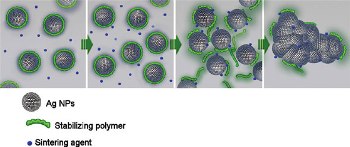Research in the field of metal nanoparticle printing is targeted at metallic ink used for metallization. Silver and gold nanoparticle inks have been printed in the inkjet form to create MEMS, conductors and RFID markers.
 HUJI's Self0sintering process
HUJI's Self0sintering process
Silver and gold nanoparticles conduct electricity and do not lead to oxidation. These inks however need a post printing stage. Printing conductive features by metallic nanoparticle inks need to be followed by sintering by heating to high temperatures. The nanoparticles that create the pattern will combine to create a constant electrical contact.
Recent research has helped develop an ink that will not need heating. This can be done by adding a hidden sintering agent that starts working after the printing. After the solution vaporizes, the sintering agent concentrate increases, causing the nanoparticles to sinter involuntarily. Shlomo Magdassi at the Institute of Chemistry, the Hebrew University of Jerusalem, says that he wanted to create a system that would enable printing conductive designs without heating to high temperatures, which is essential while designing plastic electronics products.
The research paper recently appeared in ACS Nano titled, ‘Conductive Inks with a Built-In Mechanism That Enables Sintering at Room Temperature’.